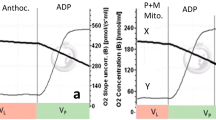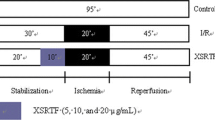Abstract
Despite being reported to reduce the risk of cardiovascular diseases, little is known about acute direct effects of bilberry anthocyanins on whole mammalian heart under ischemia–reperfusion (I–R) conditions. Bilberry anthocyanins were prepared from the ripe bilberries and analyzed using HPLC–DAD. Their antioxidant activity was evaluated by measuring the intrinsic free radical–scavenging capacity and by cellular antioxidant assay (CAA) on endothelial cells, where we quantified the intracellular capacity to inhibit the formation of peroxyl radicals. Experiments on the isolated rat hearts under I–R were carried out according to the Langendorff method. Perfusion with low concentrations of bilberry anthocyanins (0.01–1 mg/L) significantly attenuated the extent of I–R injury as evidenced by decreasing the release rate of LDH, increasing the postischemic coronary flow, and by decreasing the incidence and duration of reperfusion arrhythmias. High concentrations (5–50 mg/L) diminished cardioprotection and show cardiotoxic activity despite having their radical scavenging and intracellular antioxidant capabilities increased in a concentration-dependent manner. This study reveals the biphasic concentration-dependent bioactivity of bilberry anthocyanins under I–R, which results in strong cardioprotective activity in low concentrations and cardiotoxic activity in high concentrations.









Similar content being viewed by others
References
Knekt, P., Kumpulainen, J., Järvinen, R., Rissanen, H., Heliövaara, M., Reunanen, A., et al. (2002). Flavonoid intake and risk of chronic diseases. American Journal of Clinical Nutrition, 76, 560–568.
Rouanet, J.-M., Decorde, K., Del Rio, D., Auger, C., Borges, G., Cristol, J.-P., et al. (2010). Berry juices, teas, antioxidants and the prevention of atherosclerosis in hamsters. Food Chemistry, 118, 266–271.
Zafra-Stone, S., Yasmin, T., Bagchi, M., Chatterjee, A., Vinson, J. A., & Bagchi, D. (2007). Berry anthocyanins as novel antioxidants in human health and disease prevention. Molecular Nutrition & Food Research, 51, 675–683.
Wang, S. Y., & Jiao, H. (2000). Scavenging capacity of berry crops on superoxide radicals, hydrogen peroxide, hydroxyl radicals, and singlet oxygen. Journal of Agriculture and Food Chemistry, 48, 5677–5684.
Youdim, K., McDonald, J., Kalt, W., & Joseph, J. (2002). Potential role of dietary flavonoids in reducing microvascular endothelium vulnerability to oxidative and inflammatory insults (small star, filled). The Journal Of Nutritional Biochemistry, 13, 282–288.
Bell, D., & Gochenaur, K. (2006). Direct vasoactive and vasoprotective properties of anthocyanin-rich extracts. Journal of Applied Physiology, 100, 1164–1170.
Schewe, T., Steffen, Y., & Sies, H. (2008). How do dietary flavanols improve vascular function? A position paper. Archives of Biochemistry and Biophysics, 476, 102–106.
Halliwell, B. (2008). Are polyphenols antioxidants or pro-oxidants? What do we learn from cell culture and in vivo studies? Archives of Biochemistry and Biophysics, 476, 107–112.
Halliwell, B. (2009). The wanderings of a free radical. Free Radical Biology and Medicine, 46, 531–542.
Wolfe, K. L., & Liu, R. H. (2007). Cellular antioxidant activity (CAA) assay for assessing antioxidants, foods, and dietary supplements. Journal of Agriculture and Food Chemistry, 55, 8896–8907.
Lätti, A. K., Riihinen, K. R., & Kainulainen, P. S. (2008). Analysis of anthocyanin variation in wild populations of bilberry (Vaccinium myrtillus L.) in Finland. Journal of Agriculture and Food Chemistry, 56, 190–196.
Blois, M. S. (1958). Antioxidant determinations by the use of a stable free radical. Nature, 181, 1199–1200.
Wroblewski, F., & Ladue, J. S. (1955). Lactic dehydrogenase activity in blood. Proceedings of the Society for Experimental Biology and Medicine, 90, 210–213.
Walker, M. J., Curtis, M. J., Hearse, D. J., Campbell, R. W., Janse, M. J., Yellon, D. M., et al. (1988). The Lambeth Conventions: guidelines for the study of arrhythmias in ischaemia infarction, and reperfusion. Cardiovascular Research, 22, 447–455.
Angelone, T., Pasqua, T., Di Majo, D., Quintieri, A. M., Filice, E., Amodio, N. et al. (2010). Distinct signalling mechanisms are involved in the dissimilar myocardial and coronary effects elicited by quercetin and myricetin, two red wine flavonols. Nutrition, metabolism, and cardiovascular diseases: NMCD.
Forstermann, U. (2010). Nitric oxide and oxidative stress in vascular disease. Pflügers Archiv European Journal of Physiology, 459, 923–939.
Alvarez-Castro, E., Campos-Toimil, M., & Orallo, F. (2004). (−)-Epigallocatechin-3-gallate induces contraction of the rat aorta by a calcium influx-dependent mechanism. Naunyn-Schmiedeberg’s Archives of Pharmacology, 369, 496–506.
Saponara, S., Sgaragli, G., & Fusi, F. (2002). Quercetin as a novel activator of L-type Ca(2+) channels in rat tail artery smooth muscle cells. British Journal of Pharmacology, 135, 1819–1827.
Amorini, A., Lazzarino, G., Galvano, F., Fazzina, G., Tavazzi, B., & Galvano, G. (2003). Cyanidin-3-O-beta-glucopyranoside protects myocardium and erythrocytes from oxygen radical-mediated damages. Free Radical Research, 37, 453–460.
Fantinelli, J. C., Schinella, G., Cingolani, H. E., & Mosca, S. M. (2005). Effects of different fractions of a red wine non-alcoholic extract on ischemia-reperfusion injury. Life sciences, 76, 2721–2733.
Pataki, T., Bak, I., Kovacs, P., Bagchi, D., Das, D. K., & Tosaki, A. (2002). Grape seed proanthocyanidins improved cardiac recovery during reperfusion after ischemia in isolated rat hearts. American Journal of Clinical Nutrition, 75, 894–899.
Bertuglia, S., Malandrino, S., & Colantuoni, A. (1995). Effect of Vaccinium myrtillus anthocyanosides on ischaemia reperfusion injury in hamster cheek pouch microcirculation. Pharmacological Research, 31, 183–187.
Tarahovsky, Y. S., Muzafarov, E. N., & Kim, Y. A. (2008). Rafts making and rafts braking: How plant flavonoids may control membrane heterogeneity. Molecular and Cellular Biochemistry, 314, 65–71.
Kusumi, A., & Suzuki, K. (2005). Toward understanding the dynamics of membrane-raft-based molecular interactions. Biochimica et Biophysica Acta, 1746, 234–251.
Cvorovic, J., Tramer, F., Granzotto, M., Candussio, L., Decorti, G., & Passamonti, S. (2010). Oxidative stress-based cytotoxicity of delphinidin and cyanidin in colon cancer cells. Archives of Biochemistry and Biophysics.
Kahkonen, M. P., Heinamaki, J., Ollilainen, V., & Heinonen, M. (2003). Berry anthocyanins: Isolation, identification and antioxidant activities. Journal of the Science of Food and Agriculture, 83, 1403–1411.
Borkowski, T., Szymusiak, H., Gliszczynska-Rwiglo, A., Rietjens, I., & Tyrakowska, B. (2005). Radical scavenging capacity of wine anthocyanins is strongly pH-dependent. Journal of Agriculture and Food Chemistry, 53, 5526–5534.
Fukumoto, L. R., & Mazza, G. (2000). Assessing antioxidant and prooxidant activities of phenolic compounds. Journal of Agriculture and Food Chemistry, 48, 3597–3604.
Lazzè, M. C., Pizzala, R., Perucca, P., Cazzalini, O., Savio, M., Forti, L., et al. (2006). Anthocyanidins decrease endothelin-1 production and increase endothelial nitric oxide synthase in human endothelial cells. Molecular Nutrition & Food Research, 50, 44–51.
Schmitt, C., & Dirsch, V. (2009). Modulation of endothelial nitric oxide by plant-derived products. Nitric Oxide.
Moskaug, J. Ø., Carlsen, H., Myhrstad, M. C. W., & Blomhoff, R. (2005). Polyphenols and glutathione synthesis regulation. American Journal of Clinical Nutrition, 81, 277S–283S.
Han, K.-H., Sekikawa, M., Shimada, K.-i., Hashimoto, M., Hashimoto, N., Noda, T., et al. (2006). Anthocyanin-rich purple potato flake extract has antioxidant capacity and improves antioxidant potential in rats. British Journal of Nutrition, 96, 1125–1133.
Steffen, Y., Schewe, T., & Sies, H. (2007). (−)-Epicatechin elevates nitric oxide in endothelial cells via inhibition of NADPH oxidase. Biochemical and Biophysical Research Communications, 359, 828–833.
Ferrándiz, M. L., & Alcaraz, M. J. (1991). Anti-inflammatory activity and inhibition of arachidonic acid metabolism by flavonoids. Agents Actions, 32, 283–288.
Haddad, J. J. (2002). Antioxidant and prooxidant mechanisms in the regulation of redox(y)-sensitive transcription factors. Cellular Signalling, 14, 879–897.
Tsuda, T., Horio, F., & Osawa, T. (1999). Absorption and metabolism of cyanidin 3-O-beta-d-glucoside in rats. FEBS Letters, 449, 179–182.
Morazzoni, P., Livio, S., Scilingo, A., & Malandrino, S. (1991). Vaccinium myrtillus anthocyanosides pharmacokinetics in rats. Arzneimittelforschung, 41, 128–131.
Kay, C. D., Mazza, G. J., & Holub, B. J. (2005). Anthocyanins exist in the circulation primarily as metabolites in adult men. Journal of Nutrition, 135, 2582–2588.
Scarabelli, T. M., Mariotto, S., Abdel-Azeim, S., Shoji, K., Darra, E., Stephanou, A., et al. (2009). Targeting STAT1 by myricetin and delphinidin provides efficient protection of the heart from ischemia/reperfusion-induced injury. FEBS Letters, 583, 531–541.
Acknowledgments
We thank the reviewers for their suggestions that improved this paper. We are grateful for the financial support by the Slovenian Research Agency [research projects J3-0024 and Z4-2280]; grant for international mobility of students (Ad Futura, Slovenia); Università di Trieste (Italy); Fondazione Cassa di Risparmio di Trieste and Ministero degli Affari Esteri (Cooperazione scientifica e tecnologica Italia-Slovenia 2006-2009).
Conflict of interest
None declared.
Author information
Authors and Affiliations
Corresponding author
Rights and permissions
About this article
Cite this article
Ziberna, L., Lunder, M., Moze, S. et al. Acute Cardioprotective and Cardiotoxic Effects of Bilberry Anthocyanins in Ischemia–Reperfusion Injury: Beyond Concentration-Dependent Antioxidant Activity. Cardiovasc Toxicol 10, 283–294 (2010). https://doi.org/10.1007/s12012-010-9091-x
Published:
Issue Date:
DOI: https://doi.org/10.1007/s12012-010-9091-x




